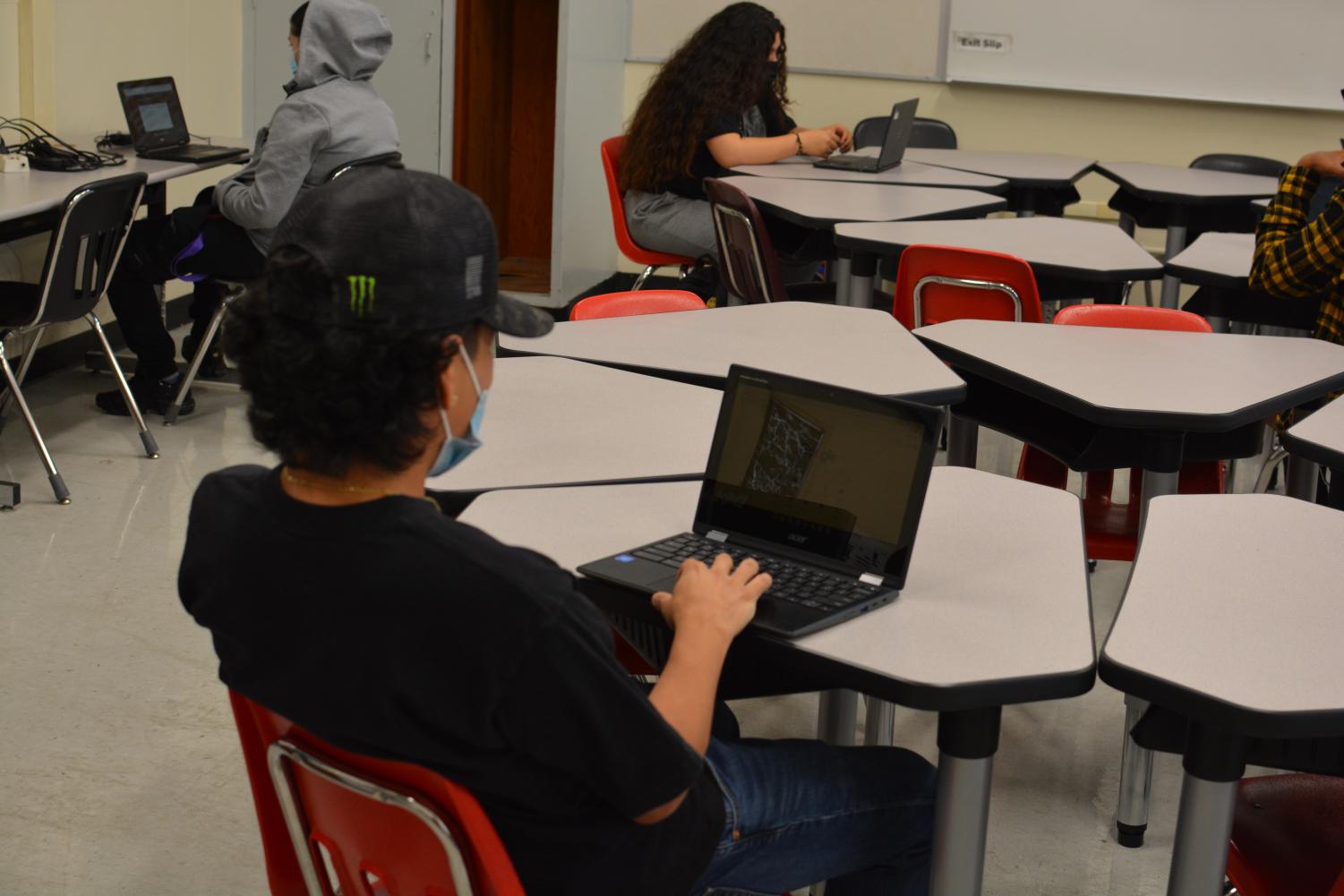Opinion: New districtwide MAP testing: what’s the verdict?
September 27, 2021
Last week, students in grades 7-12 across the Colton Joint Unified School District participated in the first of three MAP tests this year. The MAP (Measurable Annual Progress) is the creation of the Northwest Evaluation Association (NWEA), and the district aims to use this test as a way to monitor student progress towards meeting grade level state academic standards.
At Colton High, every student in grades 9-12 were required to take the MAP test. Two of those students, Pepper Bough staffers Erin Dallatorre and Briana McMullen, have some thoughts in this edition of “Point/Counterpoint.”
Max Curry takes the MAP test, which will help his teachers determine better ways to support him.
MAP testing’s benefits outweigh any feelings about it
Although some teachers and students weren’t confident about the tests, the MAP test was more beneficial than harmful to everyone.
The NWEA MAP testing is a self-adjusting test that displays either harder or easier questions based on student performance during the test.
It is similar to the all too familiar Student Reading Inventory (SRI) test that students take to measure their reading levels. Both the SRI and MAP tests are adaptive and non-stress-inducing because it is nearly impossible to prepare for them, nor is failing a possibility.
Senior Brooke Carlson says, “Overall, I thought that the tests can benefit students in the long run and set goals for the years to come.”
MAP testing’s main purpose is to see where students are after one-and-a-half school years of distance learning.
The information gained from the student results will be used by teachers to better help and support their students towards filling learning gaps. There is no downside to teachers offering students help where they need it the most.
Furthermore, one anonymous student in Mr. Silveira’s AP Economics said, “It is a bit helpful to see and realize where I am in a subject.”
Another added, “I think this MAP test was good because it tests your brain”
Opinions like these see MAP testing in a golden light, but it does not represent the majority of student’s viewpoints. Most students see MAP testing as not important and a waste of class time. Especially for AP classes.
The lack of understanding and information given by the school enables this kind of thinking.
If the testing’s purpose was further fleshed out to the students then they would’ve better understood how advantageous it is to them and their learning.
In the end, students were informed beforehand about the tests and encouraged towards proper self-care to ensure they performed to the best of their abilities. There was no pressure on the students from the teachers or staff to reach a certain score.
MAP testing does more good than bad for both students and teachers with its superior grading system and purpose.
As students get set to take the MAP test, the frustrations mount with the new testing interface.
MAP testing frustrates both students and teachers
Last Monday was the start of the NWEA MAP testing, but a lot of teachers experienced technical difficulties.
The MAP testing was an all-week event that took place during a special 96-minute period. Students were tested in reading, language, math, and science using the NWEA software, which wasn’t always easy to use or accessible.
Even Ms. Murphy was frustrated with it because she experienced WiFi issues while she was in the auditorium assisting students who couldn’t finish the test during the scheduled 96 minute period.
In addition to tech concerns, some students did not take the test seriously because they did not know why they were taking it, or what it counted towards. Freshman Joceline Lopez said, “I didn’t know until after the test that the score we got on the test would determine if I would stay in Honors English or if I would have regular English.”
Students weren’t given much information on the topic. Meanwhile, teachers were given too much information.
Although some students were taught how to access the test beforehand, there were still quite a bit of issues involving getting into the test. While some teachers like Launa Kennedy guided her students through the practice test, not all teachers did the same.
ROP Graphics Communication teacher, Tom Wurz was given an abundance of information but struggled to pick it apart and find what was most necessary to focus on with students.
Another struggle Mr. Wurz had mentioned that MAP testing took away the time teachers need to teach their students.
Advanced Placement economics and government teacher Stephan Silveira agreed. “The only issue is the amount of time it takes away from the educational minutes of each class. For example, for me with my AP students, it makes my week more difficult because I need all the time I can get. I only have one semester to teach my students a college-level course. So I need that time, considering all the other things that take away from instruction in the school year.”
An extension on the amount of time for students to complete the test would have also been helpful.
Next time, the school should take more time to explain what the test is to the students, rather than just teaching them how to access the test.


